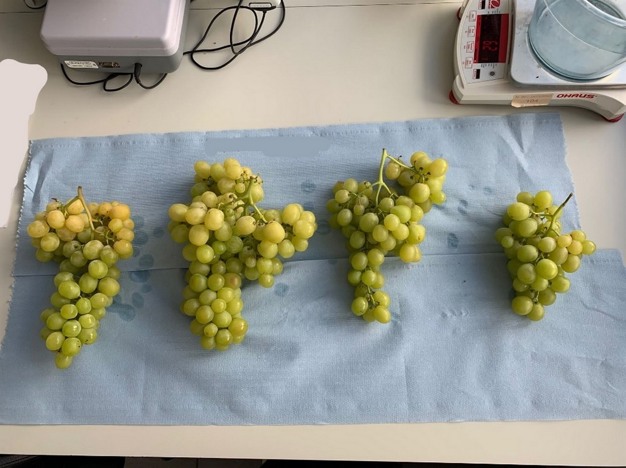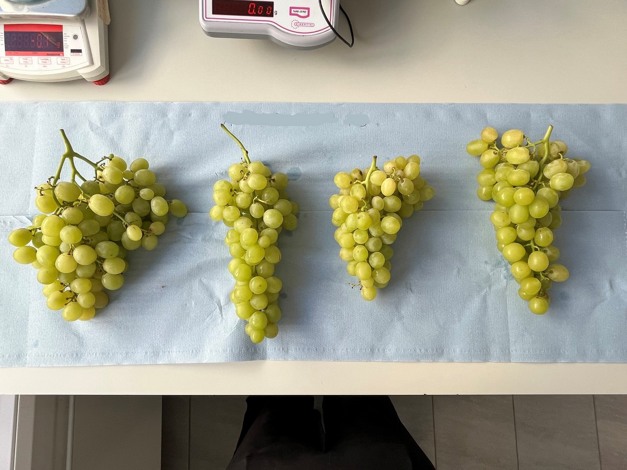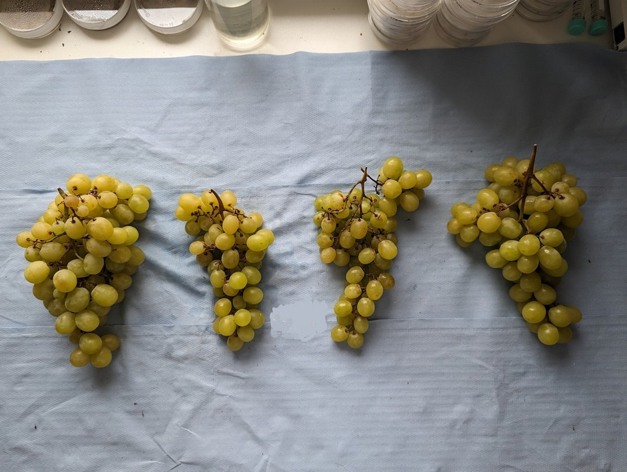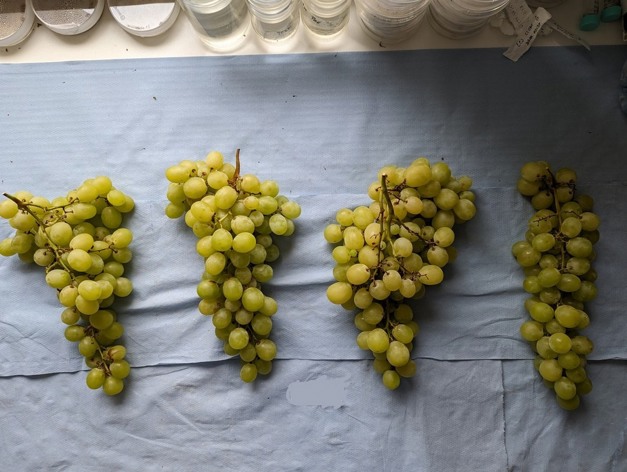The Italian Research Center for Viticulture and Enology (CREA-VE) will soon begin conducting field tests at its Turi facility to determine how thermal conditions during the grape growing cycle can affect parameters such as berry firmness and dehydration, which can reduce the quality and shelf life of grapes and accelerate the ripening process.
The research team, made up of Marco Vendemia, Leonardo Scarano, Giovanna Forte and coordinated by Antonio Coletta and Giovanni Gentilesco, describes the importance of understanding what happens during the storage period, focusing on the fundamental impacts resulting from and caused by using different cover sheets in the field.
Growers can successfully mitigate heat stress, ensure optimal growing conditions for the grapes, and improve overall product quality by combining strategies and carefully managing sheet reflectivity and transparency.
It is well known that the shelf life of grapes, or any perishable food, is affected by several factors: temperature, humidity, packaging, and exposure to ethylene. While these parameters may vary depending on the variety of grapes grown, they are all undoubtedly related to the time of harvest and the quality of the grapes.
The quality, taste, storage and shelf-life of grapes are significantly influenced by their degree of ripeness at the time of harvest. Since these parameters are related to the control of temperature and the effects of heat, which are becoming more frequent and more intense with climate change, it is worth noting that these parameters can be influenced both by the type of plastic protection installed in the vineyard and by the way it is set up.
By carefully monitoring several factors, including acidity and pH levels, tannin, and sugar, growers can help extend the shelf life of table grapes by choosing the right time to harvest.
Commercial aspects of growing conditions under plastic, relevant parameters for grape appearance.
Hardness and firmness
Grapes exposed to heat stress are prone to dehydrating, resulting in reduced berry size and increased sugar concentration. Excessive heat during ripening can accelerate water loss from the berries, causing the berries to dehydrate and shrink. The berries may shrivel and lose firmness. This can result in poor mouthfeel and an overall unpleasant experience.
 Fig. 1 The condition of clusters grown under a sheet that causes a higher level of stress.
Fig. 1 The condition of clusters grown under a sheet that causes a higher level of stress.
 Fig. 1 Condition of clusters grown under sheets that increases freshness
Fig. 1 Condition of clusters grown under sheets that increases freshness
Titratable acidity
Titratable acidity is essential to the balance and perceived freshness of grapes.
The effect of heat on the titratable acidity and aroma in grapes can have a significant impact on their shelf life and overall quality. Let's take a look at how exposure to high temperatures can affect these aspects and what the consequences can be. Exposure to high temperatures can cause a reduction in the titratable acid content of grapes. Heat can accelerate metabolic processes that cause organic acids to degrade. The reduction in titratable acidity is a factor in the loss of freshness and overall quality of the grapes. Grapes may have a flatter flavor profile, lacking the vibrancy associated with fresh fruit. The loss of acidity and flavor can also affect the texture of the grapes. They may become softer and less crisp. This reduction in texture further contributes to a decrease in customer preference and reduces the shelf life of the grapes.
Color development
Grape color is an important indicator of ripeness. Different grape varieties change color as they ripen. Harvesting at the right color stage ensures that the grapes are fully developed and ready for consumption. High temperatures can cause scorch and dehydration on the side directly exposed to light. This can also influence the appearance of the rachis and the surrounding berries, causing discoloration or over-coloration and potentially compromising the overall quality of the cluster (Fig. 2).
 Fig. 2 - Grapes after 35 days of cold storage, grown under a sheet that causes a higher level of stress
Fig. 2 - Grapes after 35 days of cold storage, grown under a sheet that causes a higher level of stress
 Fig. 2 - Grapes after 35 days of cold storage grown under a sheet that increases freshness
Fig. 2 - Grapes after 35 days of cold storage grown under a sheet that increases freshness
Appearance of the rachis
High temperatures during the growing cycle of the grape can affect the appearance of the rachis, resulting in dehydration and early browning of the rachis during the storage period.
Uneven ripening
High temperatures can contribute to uneven ripening, either within a cluster or between different clusters. This uneven ripening can affect the visual appearance of the rachis and the overall appearance of the cluster.
Control and mitigation of environmental conditions for grapes grown with plastic sheets
The use of plastic sheeting can be seen as an adaptation strategy to the various challenges associated with growing conditions. It can be used to counteract poor conditions that can adversely affect quality and shelf life.
Basically, plastic covers can protect against adverse weather conditions such as sudden drops in temperature, frost or heavy rainfall, especially during the vulnerable stages of grape development, while also preventing damage to flowers and fruit.
At the same time, the use of plastic sheeting with careful temperature control and shading techniques can help to maintain a final product that meets the desired market standards, especially during the warmer periods of the year.
Microclimatic analysis allows a detailed analysis of the microclimate under the plastic sheeting. These are conditions that are closely related to the choice of plastic film and are aimed at obtaining strategies to mitigate the conditions specific to the vineyard for factors such as temperature, humidity and air flow.
The following are some measures to mitigate critical weather conditions when using plastic sheeting.
Opting for reflective plastic sheeting
Heat reduction under plastic sheeting can be achieved mainly through reflectivity. This parameter is critical for optimizing thermal conditions.
The use of reflective plastic mulch on the soil surface around the vines. Reflective films can reflect sunlight back to the vines, reducing heat absorption by the soil. Heat reflective plastic sheet, which is designed to reflect infrared radiation, can help reduce the amount of heat absorption by the vines and soil.
Adjusting the transparency of the sheet
The use of shade screens with different degrees of transparency can be used to modulate the amount of sunlight reaching the grapes. Adjustable levels of shade can be particularly useful during periods of intense heat to provide the right balance between light and heat.
Light diffuser sheets
These screens are based on the use of films that can diffuse rather than concentrate sunlight. The diffused light reduces the intensity of direct sunlight. This minimizes the risk of heat stress to the grapes.
Row Orientation
The north-south orientation of the rows ensures that both sides of the vines receive the same amount of sunlight. This minimizes the risk of excessive exposure of one side to direct sunlight and the risk of heat stress on the grapes.
The research is being conducted in Apulia in experimental plots on several local farms and two seedless varieties. Films and sheets produced by the Campania-based company Retilplast will be used during the first year of the experiment. More information about the experiment will be available at Turi del Centro.
For more information:
Consiglio per la ricerca in agricoltura e l'economia agraria
Centro di ricerca per la viticoltura e l'enologia
Via Casamassima 148, 70010 Bari (Italia)
E-mail: [email protected]







